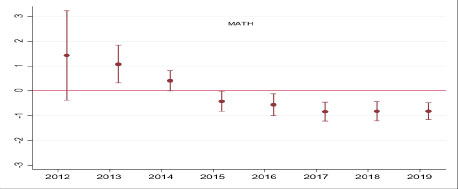Does Competition Help Schools?
Summary
While competition may have some initial benefits in schooling, a new study of Indiana's voucher program finds the long-term effects of competition have detrimental impacts on public schools and student outcomes.
Competition has the potential to increase effectiveness in schools as it does in other sectors. Consumers make shopping choices quite frequently, and when companies compete for customers’ business, they often innovate to produce better products or lower prices. That competition typically forces bad businesses to improve or close. Indeed, reformers have embraced this logic by introducing competition in education through charter schools, voucher programs, and open-enrollment plans. Schools can then compete in a variety of ways: by increasing achievement, by hiring more effective teachers, or by adopting a proven, parent-desired curriculum.
The extent to which this actually works has been studied for some time. Some research, especially from other countries, raises questions, suggesting that schools may engage in marketing or other efforts to attract more "desirable students" while avoiding harder-to-serve populations, leading to greater segregation despite the potential of choice programs to break down district barriers. Other research, mostly from the US, finds beneficial effects from competition on student learning, as public schools more subjected to competition often show greater performance gains. However, most of that research examines only the short-term effects of competition.
A recent peer-reviewed study of impacts of competition in schooling finds that "shock" may cause initial and ephemeral increases in student performance in the short run but has a detrimental impact as time goes on. Using data from National Center for Education Statistics, Indiana Department of Education and the Private School Universe Survey, CEEP Associate Researcher Yusuf Canbolat examined changes in the percentage of proficient students in light of the proportion of students using vouchers to attend private schools — as the measure of competition — in all the districts in the state. He also used the number of voucher-accepting private schools within a certain radius as a proxy for market density. The analysis compared the percent of proficient students at a school and the amount of competition those schools faced over time.
In the long run, rather than increased efficiency, schools subjected to more competition instead see lowered proficiency rates (see Figures Below), potentially due to sorting of the high performing students into the higher performing schools and the low performing students into lower performing schools.


Note: “The above figures plot the change in the relationship between competition and percent proficient students over years" (Canbolat, 2021, p. 14).
In fact, the public schools that face the highest levels of competition are the most likely to see the most dramatic decrease in performance in the long term despite having ostensibly the greatest reasons to become more productive and, unlike businesses, there is evidence that schools may not necessarily improve in the face of competition. The reasons for this are not yet completely clear but could possibly lie in the fact that public schools have to educate all children, and cannot make up for the loss of high performing students and the tax dollars that follow them, no matter how effective their curriculum or competent their teachers.
This brief is based on a study in Education Policy Analysis Archives.
Canbolat, Y. (2021). The long-term effect of competition on public school achievement: Evidence from the Indiana Choice Scholarship Program. Education Policy Analysis Archives, 29 (97). https://doi.org/10.14507/epaa.29.6311
Authors
Yusuf Canbolat is a Ph.D. candidate at Indiana University Bloomington in Education Policy studying school choice and organization both in the US and internationally.
Edited by: Jason Curlin & Christopher Lubienski, Center for Evaluation and Education Policy

